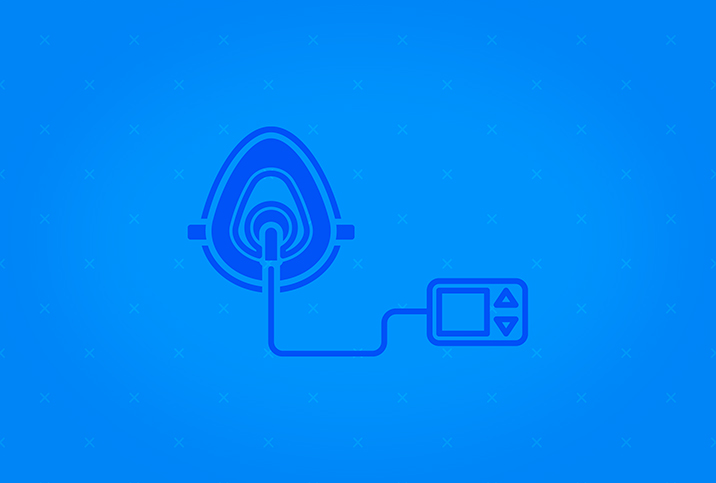Sleep Apnea Is Ruining More Than Your Partner's Sleep

We know sleep is a keystone for most health goals, but we may not realize quality is equally, if not more, important to how many hours we get each night. Many people may not be getting that quality: The American Academy of Sleep Medicine (AASM) estimates that about 23.5 million adults in the United States have undiagnosed sleep apnea.
"There is a long-held belief that when someone snores that they must be having a restful night's sleep," said Abhinav Singh, M.D., an AASM fellow and facility director of the Indiana Sleep Center in Greenwood. "However, sleep should be a silent and restorative event. Loud snoring is an indication of obstruction and your body fighting for oxygen, which is the furthest thing from a restful night's sleep."
Why people don't seek help
"One of the primary reasons why so many patients wait to be diagnosed is that they downplay their condition," Singh explained. "They wake up tired every morning, their partner complains about their snoring, but they just think their partner is being overly dramatic or they don't understand the danger of their condition."
Singh added that sleep apnea and snoring are conditions society doesn't take seriously. This is no surprise when we consider Americans rarely get the recommended seven to nine hours of sleep and, in fact, 70 percent of adults report that they experience insufficient sleep, according to the American Sleep Apnea Association (ASAA).
"Adults with moderate to severe sleep apnea experience two times the health impacts—such as stroke and heart attacks—and are more likely to have diabetic complications," said Raj C. Dedhia, M.D., otorhinolaryngology (ear, nose and throat) and sleep medicine specialist at Penn Medicine in Philadelphia.
"We also know that women who are 60 and older have complications that are similar to men's," he added. "This is thought to be caused by the decreased production of progesterone after menopause, which can cause muscle relaxation in the trachea and increase the risk of sleep apnea."
'This condition happens while we're asleep, so we don't see how dramatically it can impact our body.'
With so many risks, why do so few adults seek treatment? The first problem is public awareness.
"Sleep apnea is just not sexy enough to gain attention," Singh said. "This condition happens while we're asleep, so we don't see how dramatically it can impact our body."
He explained that diagnosed patients or people who suspect they have sleep apnea wait to seek treatment or stop their treatment because the most common approach, continuous positive airway pressure (CPAP), just doesn't work for them. A CPAP machine is used during sleep and requires the patient to wear a mask that covers the nose or face and applies a continuous supply of air.
"Fifty percent of patients who use CPAP will either return it or not use it properly," Dedhia said. "This is because CPAP is cumbersome, loud and oftentimes, patients cannot get used to the apparatus on their faces. Many patients are embarrassed to wear the machine around their partners, and if they do, they might wear it for the first few hours of sleep and then take it off.
"We know that the worst sleep apnea events occur during REM sleep, and REM sleep happens in the second half of sleep, so taking off the CPAP halfway through the night defeats the purpose of using the machine at all," he continued.
Finding the right treatment
When a person's sleep apnea goes untreated, their cardiovascular system must withstand constant stress during sleep. A lack of oxygen plus increased carbon dioxide in the bloodstream and organ systems means the heart has to work harder to keep the body functioning properly. As a result, patients with obstructive sleep apnea have a higher risk of sudden cardiac death, according to Cleveland Clinic.
"The most important message we can share is to give patients hope," Dedhia said. "The failed CPAP treatment is not the patient's fault."
Obstructive sleep apnea occurs when the muscles that support the soft tissue in the throat relax, narrowing or closing the airway and temporarily cutting off breathing.
Dedhia said despite the many available treatments, sleep apnea most often can be treated by closing the patient's mouth. This might seem odd, but closing the mouth, aligning the jaw and repositioning the tongue stabilizes the throat, which prevents collapse of the airway.
'Patients with obstructive sleep apnea have a higher risk of sudden cardiac death.'
"The most important step in treating sleep apnea is to get a comprehensive picture of the causes of a patient's sleep apnea and educate the patient so they understand the importance of treating this cause," Dedhia said.
In minor cases, most patients find success using mouth tape or a closure device that keeps the mouth closed while they sleep. In severe cases, patients have many options, including jaw surgery, which involves breaking the jaw and realigning it to help the patient breathe better.
"Many patients with moderate sleep apnea find success using the Inspire device," Dedhia noted, describing the device as "a pacemaker for the tongue." The Inspire device requires electrodes to be implanted in the chest and neck, and when the tongue slides back during sleep, these electrodes activate, moving the tongue forward to prevent a blockage of the airway.
Regardles of which treatment ends up being best for you, don't wait to take action. Sleep apnea is a serious condition, and avoiding treatment leads to significant complications over time, including negative effects on cardiovascular health. The first step to getting a restful and restorative night's sleep is to commit yourself to finding the right treatment.


















